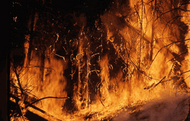Wildland Fire Policy
May 14th 2020
 In recent decades, the ability to manage wildland fires across the United States has faced increasing challenges of both size and scope. Large wildfires pose significant threats to millions of acres, both private and public. The areas of most concern are those wherein natural vegetation patterns have been disrupted by land-use practices, development, and assertive means of fire suppression. Where fuel loads have reached very high levels, the possibility of ecological deterioration has risen in kind. To help combat the risks of these types fires, federal wildland fire policy saw revisions in 1995 that promoted a proactive fire management approach.
In recent decades, the ability to manage wildland fires across the United States has faced increasing challenges of both size and scope. Large wildfires pose significant threats to millions of acres, both private and public. The areas of most concern are those wherein natural vegetation patterns have been disrupted by land-use practices, development, and assertive means of fire suppression. Where fuel loads have reached very high levels, the possibility of ecological deterioration has risen in kind. To help combat the risks of these types fires, federal wildland fire policy saw revisions in 1995 that promoted a proactive fire management approach.
Wildland fires can be notoriously difficult to predict and contain. This necessitates uniform prevention policies and agreement among all parties involved in creating/enforcing policy. To that end, the management and protection of natural resources situated on public lands falls on the Department of the Interior, the Department of Agriculture, tribal and state governments, as well as other jurisdictions. As firefighting resources are often limited in the face of large fires, the strength of the relationships among these bodies is of critical importance.
The Secretaries of the Interior and Agriculture, in 1994, chartered the Federal Wildland Fire Management Policy and Program Review. The goal of the review was to enforce the federal programs and policies to ensure cooperation among all involved governing bodies. The review was a joint effort that received contributions from the U.S. Fish & Wildlife Service, the National Park Service, the Bureau of Land Management, the Forest Service, and the Bureau of Indian Affairs. Other contributions came from FEMA, the National Weather Service, the Environmental Protection Agency, and National Biological Service. The report, upon conclusion, put forth basic principles of fire management, as well as a recommendation for federal wildland fire policies. As with any joint effort, the missions of each agency would occasionally create differences in recommendations. Despite this, however, a coordinated set fire policy was presented.
The policy, while quite broad in scope, offers some clearly defined points.
- The primary priority in wildland fire management is protecting human life. Firefighters, once committed to a fire, are the first priority. Second priority is given to property and resource values, among which fire management decisions will be based upon the values of property and resources that require protecting.
- Pre-treatment must be considered in locations where wildland fire can't safely be reintroduced due to the hazardous build up of fuels, especially where wildlands and urban areas meet.
- Federal agencies, in locations where wildlands and urban areas meet, are responsible for cooperative education and prevention, reduction of hazard fuels, firefighting, and technical assistance. State and local branches assume primary responsibility.
- Because it is a crucial natural process, wildland fire has to be reintroduces into the ecosystem. To help reach an ecosystem's long-term health goals, fire will be permitted to act as closely as possible to the way it would as a natural occurrence.
- Resource management decisions and wildland fire management decisions occur in tandem and are to be based upon approved fire management and land and resource management plans. In addition, fire managers are allowed to select from a full menu of fire management options, which includes everything from immediate fire suppression to letting a fire carry out in its normal ecological capacity.
- Where wildland and urban areas meet, tribal, state, and local governments are responsible for structural fire protection.
- The responsibility of further emphasizing educating to both internal and external audiences about the hows and whys of wildland fire management falls to federal agencies.
Success of the program is seen as depending upon four key points:
- Each agency administrator ensures the incorporation of wildlife fire policy into all actions;
- At the ground level, fire professionals work with agency administrators with respect to policies;
- Managers and staff are required to implement policy recommendations and work with constituents to help ensure their success; and,
- Each employee of every involved agency must commit to following through with policy at the ground level.
The final element is for agencies and the public alike to realize that not all wildfires can be suppressed or controlled. In combination, or individually, fuel build-ups, multiple ignitions, extreme fire behavior, and extreme weather behavior can overpower even the best planning, equipment, and technology designed to contain and control wildfires.

